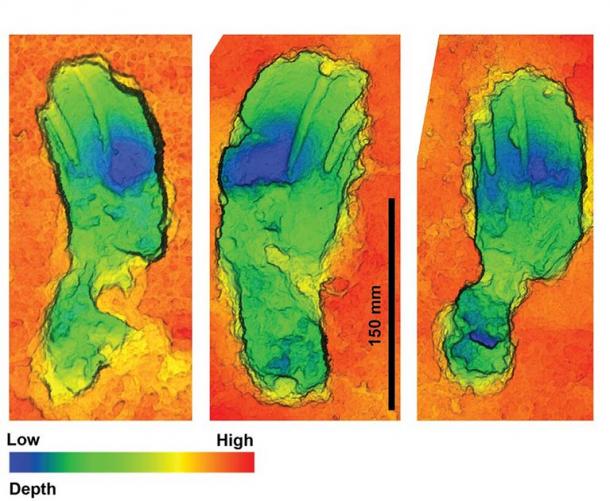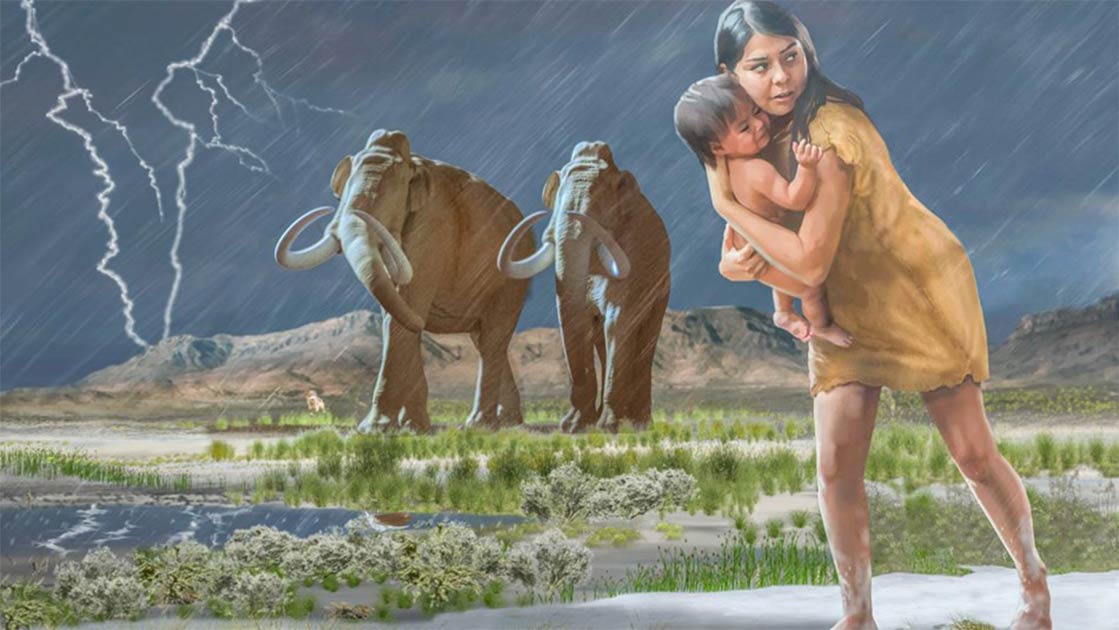10,000-Year-Old Footprints Tell Amazing Story of Human Encounter with Megafauna
Archaeologists at White Sands National Park in New Mexico examining a 10,000-year-old track of human footprints, have made more fascinating discoveries. But they’ve also unearthed a trowel-full of unanswered questions about the timeworn mystery of the relationship between humans and ice age megafauna.
Archaeology Detectives: Following Fossilized Footprints to Retrace Ancient Footsteps
The Alkali Flat in New Mexico, U.S.A, is a huge salt playa (dry lake) known as the world’s largest gypsum dune field, caused as a warming climate shrank an ancient lake bed that was eroded by the wind to create dunes and salt flats. On these flats, archaeologists have discovered hundreds of thousands of human footprints dating from the end of the last ice age (about 11,550 years ago), as well as the prints of many Ice Age megafauna that stalked, and were stalked by, early humans.
- Radar Detects Invisible ‘Ghost Tracks’ of Humans and Mammoths
- How to Hunt a Giant Sloth – Ancient Tactics Revealed in Human Footprints
- Unprecedented Wave of Large-mammal Extinctions Linked to Prehistoric Humans
In a 2018 Ancient Origins article we featured a paper that described the ancient “ghost tracks” of now extinct giant ground sloths, mastodon, mammoth, camel and dire wolf, that only become visible at the surface during specific weather conditions, and it was suggested that the humans stepped into the sloth prints as they stalked them for the kill. Moving in “large flailing circles” the giant sloth was thought to have risen up on its hind legs, sweeping its arms “to keep the hunters at bay,” and when it overbalanced its knuckles and claws thumped to the ground to steady itself. But now, in light of new evidence, this story has now changed significantly.


Top: Panorama of Alkali Flats at White Sands National Park in New Mexico during current times. (Footwarrior / CC BY-SA 3.0). Bottom: A paleontological landscape painting showing now-extinct Ice Age mammals that roamed the area of White Sands National Park during the end of the Last Ice Age, including mammoths, ground sloths, dire wolves, camelops and more. (Public domain)
Exploring the Longest Straight Track in the Ancient Americas
A new paper published in Quaternary Science Reviews greatly expands on the initial 2016 observations, presenting what is described as the “longest trackway of fossil footprints in the world.” According to PHYS.org this new discovery comes from White Sands National Park in New Mexico. The findings were made by an international team working in collaboration with staff from the National Park Service. Unlike all of the other human footprint trackways “this one is remarkable for its length, measuring at least 1.5 kilometers” (0.9 miles) and is exceptionally straight.
The linear nature of this particular track indicates that the individual did not, by even a meter, deviate from their determined course, and even more thought provoking was that the person returned on their own trackway a few hours later. Just like detectives piecing together the clues at a modern crime scene, the depths and twists of each of these footprints has been measured revealing details about every inch of the track, so accurate that they determined when the person had “slipped here, and stretched there.”

The photo shows the fossilized footprints of a double trackway. This is the remaining evidence of an outward and homeward journey of what is believed to have been a lone woman about 10,000 years ago. In the central image you can see child tracks in the middle of nowhere. (M. Bennett / Bournemouth University)
Following Footprints in the Sand
This ancient track is made up of small fossilized footprints which the researchers believe they were most likely made by a young woman, or possibly an adolescent male. From this one long, straight track they determined that because the ground was wet and slick with mud the person maintained what would have been “an exhausting speed, of over 1.7 meters per second,” compared with a comfortable walking speed of about 1.2 to 1.5 meters per second on a flat dry surface.
Do you know that popular allegorical religious poem Footprints In The Sand? “When you saw only one set of footprints, It was then that I carried you.” Well, it describes a person who sees two pairs of footprints in the sand, one of which belonged to God and another to him or herself. As the two pairs of prints become one, it is explained that this is where God was caring the person. Returning to the Alkali Flat, at several places on the outward journey a two-year-old child’s tracks were found as the carrier “set a child down, perhaps to adjust them from hip to hip, or for a moment of rest,” but while the child was carried outward, it was not present on the return journey.

Color depth-rendered 3D scans of some of the fossilized footprints uncovered. The distinctive curved shape is distinctive feature of someone walking while carrying a load. (Bournemouth University)
Readdressing the Sloth Incident
All of the above discoveries were derived from the shapes, depths and twists of the footprints which were found to be broader on the outward journey, caused by outward rotation of the foot when its owner is carrying a heavy weight, while on the homeward journey they vary less in shape with a narrower form. Furthermore, between the time the person made their outward and return journeys, a giant sloth and a mammoth crossed the outward trackway, evident due to return journey footprints crossing those animal tracks.
In contrast to the story first published by the archaeologists, that the giant sloth moved in “flailing circles on its hind legs, sweeping its arms to keep the hunters at bay,” the sloth tracks show that it had been aware of the human’s passage and when it reached this trackway it reared-up on its hind legs “to catch the scent, pausing by turning and trampling the human tracks before dropping to all fours and making off. It was aware of the danger.”
While this unique trackway has already offered deep insights into human movement 10,000 years ago, it raises as many new questions. What was the person doing alone, moving at speed, with a child, out on the dangerous playa? What is for sure is that the child-carrying woman must have felt terribly vulnerable in this wild and unpredictable landscape. Whatever her motivation was, she made her journey, delivered the child, and returned.
Top image: After further analysis of the fossilized footprints, archaeologists have adjusted the narrative of the story they tell. During the end of the last ice age, a woman holding a child hurriedly walks along the shores of the ancient Lake Otero, leaving footprints in the mud. Source: Karen Carr / NPS
By Ashley Cowie




















Comments
Reading discoveries such as this really puts into perspective how far we've come as a species.. and how our own day to day struggles are NOTHING compared to our ancient ancestors. Love learning about our past cultures .. wish I was young again as I'd strive to learn more in a professional capacity. Captivating history...
Tara Lewis